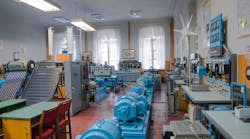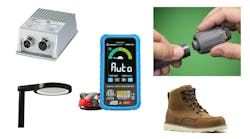There seems to be a growing opinion among some people in the electrical industry that in the United States and its territories, all electrical equipment must be “listed” by a Nationally Recognized Testing Laboratory (NRTL) to be Occupational Safety and Health Act and National Electrical Code (NEC) compliant (for a full list of OSHA-recognized NRTLs, visit www.osha.gov). Although this may be a good idea, especially for those responsible for code enforcement, it is simply not the case. Furthermore, it is not possible to purchase listed or NRTL-listed electrical equipment 100% of the time. So, how do you determine when it is necessary to use a listed product and when it is not?
Both OSHA and the NEC use a variety of terms describing how an electrical installation may be “approved” or “acceptable” to the authority having jurisdiction (AHJ). If an NRTL lists the equipment, that certainly helps an inspector determine the suitability and acceptance of an electrical installation. In these cases, it is a simple process for the inspector to verify the equipment is being used properly and is installed per the markings, labeling, or instructions provided by the manufacturer. There are many types of electrical equipment, including custom-made assemblies, where obtaining an individual listing would be cost- and schedule-prohibitive. Field assessment certifications may be more appropriate in these situations. Why is any of this necessary? Simply put — the safety of persons and property cannot be compromised under any circumstance.
Brushing up on the terms
You must fully understand the terminology to understand the intricate system of codes, standards, product evaluations, inspections, and approvals. OSHA and the NEC have many terms pertaining to an installation and equipment being compliant. When compliant with national standards and codes, the installation is usually acceptable to the AHJ. Only where OSHA, the NEC, or other enforceable codes require products to be listed must they be evaluated and “labeled” or “marked” as such.
Other terms in our codes, such as “recognized,” “identified,” and “certified” are equally important. Unfortunately, it is common in our industry to witness the misuse of these terms or hear them used interchangeably. Doing so can lead to much confusion, not to mention errors and misunderstandings. Depending on the severity of the misunderstanding, misuse, or miscommunication, there may be unwanted costs, schedule delays, and even legal issues as a result.
What OSHA says
Breaking it into more granularity, let us review the details of an acceptable electrical installation. Before addressing NEC requirements, however, let’s look at federal OSHA requirements. OSHA 29 Code of Federal Regulations (CFR) Part 1910, Subpart S and 26 CFR Part 1926, Subpart K apply to electrical installations for general industry and construction, respectively. Part 1910, Subpart S and Part 1926, Subpart K requirements and terms are similar, and both differ somewhat from the NEC. Although not exactly the same, the objectives of OSHA and the NEC are aligned. Since Parts 1910 and 1926 are similar, only §1910, Subpart S will be examined in this article. It should also be noted that states may either apply the federal version of OSHA laws or develop and enforce their own, and some do.
Focusing on §1910, Subpart S, Sec.1910.303(a) states that electrical conductors and equipment required or permitted by Subpart S will be “…acceptable only if approved as defined in §1910.399.”
§1910.303(a) — Approval. The conductors and equipment required or permitted by this subpart shall be acceptable only if approved, as defined in §1910.399.
§1910.303(b)(1)(i) then describes how equipment and installation may be “suitable.” We have already determined that electrical equipment and installations must be “approved” in order for them to be “acceptable.” We also see that equipment may be suitable for an “identified” purpose by having it “listed” or “labeled,” with the word “may” rather than “shall” being key.
§1910.303(b)(1)(i) — Suitability for installation and use in conformity with the provisions of this subpart;
Note to paragraph (b)(1)(i) of this section: Suitability of equipment for an identified purpose may be evidenced by listing or labeling for that identified purpose.
"Approved" is defined in S1910.399. For an OSHA compliance officer to approve of an installation, he or she must find it acceptable. So, how do we make certain our installation will be “acceptable,” and therefore “approved?”
§1910.399 — Approved. Acceptable to the authority enforcing this subpart. The authority enforcing this subpart is the Assistant Secretary of Labor for Occupational Safety and Health. The definition of "acceptable" indicates what is acceptable to the Assistant Secretary of Labor, and therefore approved within the meaning of this subpart.
§1910.399, under the definition of “acceptable,” states that our installation will be acceptable to OSHA by way of three possibilities:
(1) Addresses listing of products by an NRTL.
(2) Addresses situations where there is not a product standard or an NRTL to obtain a listed product. In this case, complying with the NEC and inspection by the local AHJ is acceptable to OSHA. It should be evident now that “listing” of electrical equipment is not always required or even achievable.
(3) Addresses custom-made or one-of-a-kind equipment, such as a control panel built for a specific application. Economically speaking, it would be cost-prohibitive to have every custom-made control panel “listed” by an NRTL. OSHA allows manufactured custom-made equipment where the manufacturer provides test data that an employer keeps on file and makes available to the OSHA inspector(s), if asked.
§1910.399 — Acceptable. An installation or equipment is acceptable to the Assistant Secretary of Labor, and approved within the meaning of this Subpart S:
(1) If it is accepted, or certified, or listed, or labeled, or otherwise determined to be safe by a nationally recognized testing laboratory recognized pursuant to § 1910.7; or
(2) With respect to an installation or equipment of a kind that no nationally recognized testing laboratory accepts, certifies, lists, labels, or determines to be safe, if it is inspected or tested by another Federal agency, or by a State, municipal, or other local authority responsible for enforcing occupational safety provisions of the NEC, and found in compliance with the provisions of the NEC as applied in this subpart; or
(3) With respect to custom-made equipment or related installations that are designed, fabricated for, and intended for use by a particular customer, if it is determined to be safe for its intended use by its manufacturer on the basis of test data which the employer keeps and makes available for inspection to the Assistant Secretary and his authorized representatives.
The term “Accepted” is also defined for Part 1910 Subpart S. This definition is probably a source of some of the misunderstandings that all electrical equipment must be listed. However, we discussed that there are three distinct paths to being acceptable and acceptable installation. In (1), the definition of “Acceptable” indicated that if an NRTL accepts, certifies, or lists the equipment, then it is acceptable to OSHA, but that is only one method in which our installation can be acceptable and therefore approved.
§1910.399 — Accepted. An installation is “accepted” if it has been inspected and found by a nationally recognized testing laboratory to conform to specified plans or to procedures of applicable codes.
One last point before we review the NEC on this subject: OSHA compliance officers can, and do, consult the NEC or other consensus standards in order to enforce the General Duty Clause 5(a)(1) and applicable CFRs. They typically do not cite NEC requirements directly as a basis for assessing penalties or fines related to an unsafe condition.
What the NEC says
As stated in the preface of the NEC, it is purely advisory as far as the National Fire Protection Association (NFPA) is concerned. It is legally enforceable only if it is adopted by an entity such as a state, county, municipality, or even another country, as law. Some people incorrectly assume that the NEC is the “law of the land” because early in their careers, someone probably told them it is.
NEC Art. 100 contains important definitions related to the approval of electrical installations by an AHJ. Then, in Sec. 110.3(a) and (b), the NEC is very precise as to how to determine if electrical equipment can be used in a specified manner, and how to achieve maximum safety for persons and property from the hazards of the use of electricity.
It is important to note that Art.110 does not state, or even imply, that all electrical equipment is required to be NRTL-listed or listed by a qualified testing laboratory to be approved. Only where the NEC specifically and clearly states equipment must be listed is the equipment required to be tested, examined, and listed by a qualified testing laboratory in accordance with an appropriate product standard, but not necessarily by an NRTL. Remember, OSHA or the other forms of it, is U.S. law, not an international statute, whereas the NEC is used globally.
NEC Art. 100 also includes definitions for a Field Evaluation Body (FEB) and Field Labels. FEBs are typically an organization that is also an NRTL, but it doesn’t’ have to be. An FEB inspector can examine equipment and affix a symbol, mark, or label indicating the FEB has determined that it complies with the requirements described in an accompanying report. Typically, field labeling is acceptable to AHJs, including OSHA inspectors, even though it probably still is not listed, only field certified.
Shades of gray
We all want safe electrical installations and safe products. It would be convenient for our inspectors to have all electrical equipment listed by an NRTL or qualified testing laboratory, but it isn’t feasible economically and neither OSHA nor the NEC requires this in all cases. Unless the AHJ enforces a code or standard that has been adopted as law, and it states specifically that the equipment must be listed, hen it does not have to be. There are other ways of achieving a safe, approved installation.
One could write a book, or even a volume of books, on this topic. It can be complex and not black and white all of the time. This brief article does not cover all the information one needs to fully understand the world of certifications, listing, labeling, NRTLs, product standards, marking, suitability, etc. It will be time well spent to dig further into this topic.
Eddie Guidry is a Senior Fellow in electrical engineering for Fluor Corp. in Sugar Land, Texas. He can be reached at [email protected].
SIDEBAR: Origins of Electrical Product Listings
Since the use of electricity became popular in the late 1800s, electrical inspectors (AHJs) have been tasked with determining the suitability and safety of electrical installations. In the 1890s, an inspector would have been hard-pressed to determine the safety of any electrical installation. In those days, most equipment was not mass-produced and was probably one-of-a-kind. William Henry Merrill recognized this as a problem that needed to be reconciled. In 1894, he founded Underwriters Laboratories (UL) to evaluate and certify electrical equipment, among other materials. As an electrical engineer, he recognized the dangers of electricity and started developing product standards to create a benchmark for equipment and materials to be evaluated and deemed safe or unsafe. UL is currently a National Recognized Testing Laboratory (NRTL) along with approximately 20 other organizations.
Fast-forward to 1970. Because many unscrupulous employers had a history of exposing their workers to unsafe conditions during the previous decades, U.S. lawmakers passed legislation in 1970 that made it illegal for employers to subject their workers to harm. The new law granted the federal government authority to inspect facilities within the scope of the statute for dangerous conditions and then assess penalties and fines, if necessary. As noted on the OSHA website:
"The Williams-Steiger Occupational Safety and Health Act of 1970 (84 Stat. 1590 et seq., 29 U.S.C. 651 et seq.) requires, in part, that every employer covered under the Act furnish to his employees employment and a place of employment which are free from recognized hazards that are causing or are likely to cause death or serious physical harm to his employees."
According to its website, OSHA employs approximately 2,100 inspectors for 130 million workers, or one compliance officer for every 59,000 workers. Therefore, the burden of inspections and enforcement falls mainly upon local jurisdictions such as states, cities, towns, boroughs, counties, or other entities like a petrochemical plant owner. Without codes, standards, and products evaluated for safe use, adequate enforcement would be nearly impossible. Our buildings, workplaces, and manufactured products would be much less safe without these requirements, directly affecting our safety.



